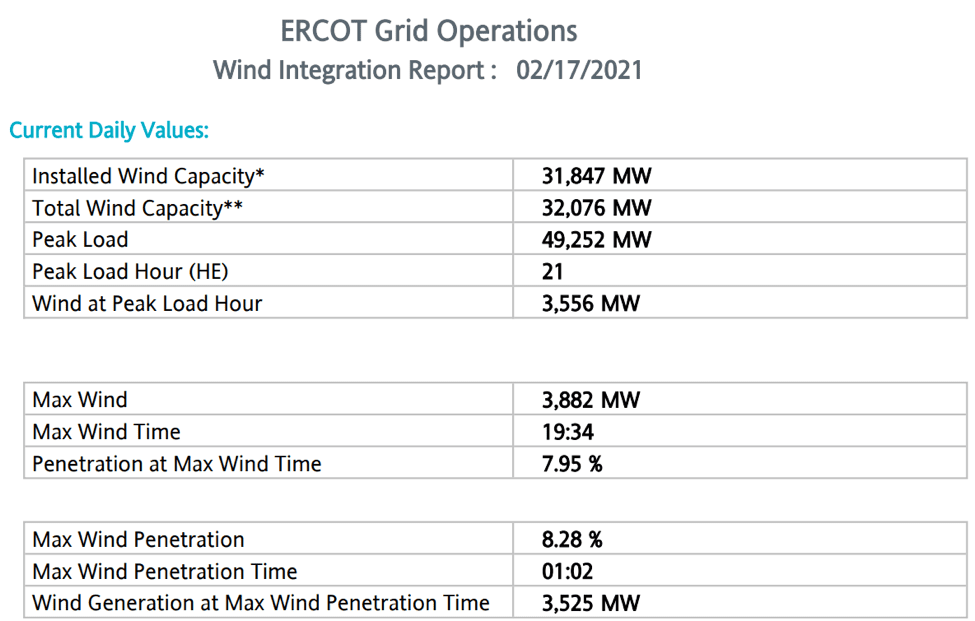This is the second installment in a series on the recent Texas power outages.
There has been a lot of debate about why Texas had rolling blackouts last week in the midst of the historic winter storm.
Poor winterization, lack of integration with the national grid, bureaucrats, deregulation, Enron’s Ken Lay, and frozen natural gas pipelines are frequent targets of politicians and media pundits for the blame.
However, the only time you will hear most of them talk about renewable energy is when they tell you that renewables were not the cause. You can almost hear the carnival huckster from Kansas saying, “Pay no attention to those frozen turbines behind the curtain.”
One such denial ran in the Austin American-Statesman last Wednesday. Nate Chute wrote that Texas’ “failing sources [of generation] largely included nuclear plants, coal plants and thermal energy generators.”
He goes on to cite numbers he attributes to ERCOT officials, though without providing actual quotes:
As of Wednesday, 46,000 megawatts of generation were offline, with 185 generating plants tripped. ERCOT officials said 28,000 megawatts came from coal, gas and nuclear plants, and 18,000 megawatts were from solar and wind.
Frozen wind turbines were a factor, too, but Woodfin said wind shutdowns accounted for less than 13 percent of the outages.
Of course, the point of his reporting here is to show that wind’s contribution to the blackouts was small in comparison to coal and natural gas. Yet his numbers are, at best, confusing.
Chute reports that of the 46,000 megawatts of generation that were offline as of Wednesday, and “18,000 megawatts were from solar and wind.” That equals 39 percent. Then he includes a graph showing us that 15,000 megawatts of wind on Tuesday at 4 p.m totaled 33 percent of, well, something—he does not specify what—as opposed to coal’s 66 percent contribution. One might assume he is talking about outage percentages, but that is unclear. Finally, he reports that “wind shutdowns accounted for less than 13 percent of the outages.”
Whatever they actually are portraying, the American-Statesman‘s numbers are clearly designed to make the case that wind and renewables generally played only a small role in the blackouts compared to coal and natural gas.
Yet the numbers from ERCOT’s own publications show something very different.

The chart above shows that on Wednesday, February 17—one of the days the American-Statesman discusses—28,291 megawatts of wind was missing at 9 p.m., i.e., the peak load hour (21). That is, almost 89 percent of wind’s total capacity was offline, and it was providing only 7.2 percent of the total load. Most of the remaining 93 percent was being supplied by nuclear, natural gas, and coal. None, however, was coming from solar, which was providing zero megawatts and operating at zero percent of its capacity. Add them together, and 90 percent of renewable generation was offline.
On Monday morning, February 15—when ERCOT announced “there is not enough generation available to meet current demand” and that it would “instruct utilities to begin rotating outages”—renewables did not perform much better. At 1 a.m., wind’s output was up to 5,350 megawatts, but demand was much higher because of the record cold. Wind was operating at 16.8 percent of its capacity—still much lower than natural gas and coal—but supplying only 8.2 percent of the 65,256 megawatt load that would soon shut down the system. And again, solar was providing zero percent of the load. Eight-five percent of renewable capacity was missing in action.
One wonders what might have happened if over the last 20 years or so investors and generators had not been chasing the $21 billion worth of subsidies and benefits they received by building renewable generation in Texas.
During most of that time, Texas has been the only market in the nation that provided reliable growth in electricity demand and thus outstanding opportunities for investors to earn a profit by building reliable natural gas and coal plants. If the money spent on the 35,000 megawatts of renewable capacity in Texas had gone instead into coal, natural gas, or nuclear generation, it might have been enough to handle all of the demand last week. This could have kept Texans from losing power at all. At the worst, we would have experienced only limited rolling blackouts and likely would not have lost water at all.
Markets work and bring prosperity. Government intervention does not work and brings poverty. If Texas leaders continue to cooperate with the corrupt renewable energy cartels we have in Texas, it might not be too long before a lot more of us start heading to Mexico to avoid the third world conditions here at home.
This is a commentary published with the author’s permission. If you wish to submit a commentary to Texas Scorecard, please submit your article to submission@texasscorecard.com.





